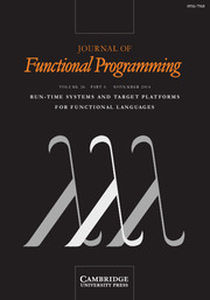Crossref Citations
This article has been cited by the following publications. This list is generated based on data provided by
Crossref.
Leijen, Daan
and
Meijer, Erik
1999.
Domain specific embedded compilers.
p.
109.
Thiemann, Peter
1999.
Practical Aspects of Declarative Languages.
Vol. 1753,
Issue. ,
p.
263.
Leijen, Daan
and
Meijer, Erik
2000.
Domain specific embedded compilers.
ACM SIGPLAN Notices,
Vol. 35,
Issue. 1,
p.
109.
Meijer, Erik
Perry, Nigel
and
van Yzendoorn, Arjan
2001.
ECOOP 2001 — Object-Oriented Programming.
Vol. 2072,
Issue. ,
p.
150.
Hanus, Michael
2001.
Practical Aspects of Declarative Languages.
Vol. 1990,
Issue. ,
p.
76.
Antoy, Sergio
and
Hanus, Michael
2002.
Functional and Logic Programming.
Vol. 2441,
Issue. ,
p.
67.
Thiemann, Peter
2002.
Practical Aspects of Declarative Languages.
Vol. 2257,
Issue. ,
p.
192.
Elsman, Martin
and
Hallenberg, Niels
2003.
Practical Aspects of Declarative Languages.
Vol. 2562,
Issue. ,
p.
74.
Elsman, Martin
and
Larsen, Ken Friis
2004.
Practical Aspects of Declarative Languages.
Vol. 3057,
Issue. ,
p.
224.
Thiemann, Peter
2005.
An embedded domain-specific language for type-safe server-side web scripting.
ACM Transactions on Internet Technology,
Vol. 5,
Issue. 1,
p.
1.
Barbosa, Marco Antonio
2005.
A refinement calculus for software components and architectures.
p.
377.
Barbosa, Marco Antonio
2005.
A refinement calculus for software components and architectures.
ACM SIGSOFT Software Engineering Notes,
Vol. 30,
Issue. 5,
p.
377.
Broberg, Niklas
2005.
Haskell server pages through dynamic loading.
p.
39.
Plasmeijer, Rinus
and
Achten, Peter
2006.
Implementation and Application of Functional Languages.
Vol. 4015,
Issue. ,
p.
106.
Hanus, Michael
2006.
Type-oriented construction of web user interfaces.
p.
27.
Plasmeijer, Rinus
and
Achten, Peter
2006.
Central European Functional Programming School.
Vol. 4164,
Issue. ,
p.
1.
Plasmeijer, Rinus
and
Achten, Peter
2006.
Functional and Logic Programming.
Vol. 3945,
Issue. ,
p.
242.
Meijer, Erik
2007.
Confessions of a used programming language salesman.
p.
677.
Plasmeijer, Rinus
and
Achten, Peter
2007.
Implementation and Application of Functional Languages.
Vol. 4449,
Issue. ,
p.
108.
Hudak, Paul
Hughes, John
Peyton Jones, Simon
and
Wadler, Philip
2007.
A history of Haskell.


Discussions
No Discussions have been published for this article.